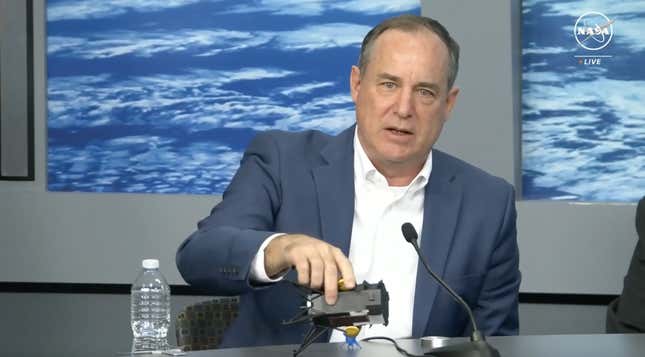Intuitive Machines’ private lander stumbled on its way down to the lunar surface and is possibly leaning over on a rock on the Moon. The vehicle is still operational and flight engineers are working to gather more data on its less-than-ideal position, the company said.
Moon Knight Gives Us Hope
Odysseus landed on the Moon on Thursday, overcoming a glitch that jeopardized its ability to safely touch down. Although it made it to the surface, Odie’s landing was not so smooth, with the vehicle getting one of its legs caught, causing it to tip over on its side and possibly end up laying on a rock, Intuitive Machines CEO Steve Altemus revealed during a press conference on Friday.
“Yesterday we thought we were upright,” Altemus said. “When we worked through the night to get other telemetry data, we noticed that in this direction [pointing downwards] is where we’re seeing the tank residuals and so that’s what tells us with fairly certain terms the orientation of the vehicle.”

“It was a quite a spicy seven-day mission to get to the Moon,” Altemus added, and he is not wrong. Intuitive Machines was racing to the lunar surface to become the first private company to land on the Moon following a series of failures by others. In January, Astrobotic failed in its attempt to reach the Moon due to a valve issue with its Peregrine spacecraft. In April 2023, Japan’s ispace Hakuto-R M1 crashed on the lunar surface, and Israel’s SpaceIL Beresheet lander met a similar fate in April 2019.
This time around, the Moon still put up a fight. Just hours before its scheduled descent, Odysseus’ laser rangefinders, which are designed to assess the Moon’s terrain to identify a safe landing spot, malfunctioned. In order to help guide the lander to the surface, flight engineers uploaded a software patch to repurpose a secondary laser on a NASA instrument that’s on board Odysseus.
The Houston-based company seemingly broke the lunar curse with Thursday’s touchdown, despite it not being entirely perfect. With the lander on its side, it is still receiving sunlight to its horizontal solar panel, and all of its active payloads are facing away from the surface and could therefore be able to operate from the Moon, according to Altemus.
Intuitive Machines secured a faint signal from its lander but it is still waiting on more data to be downlinked from Odysseus. Some of the antennas that the lander is designed to use to communicate with Earth, however, are pointed downward, which limits the mission’s ability to transmit data.
The IM-1 mission is part of NASA’s Commercial Lunar Payload Services (CLPS) initiative, which aims to have a constant flow of private landers headed to the Moon to deliver government-owned and commercial payloads. With each private trip that launches to the Moon, NASA and its partner companies collect data to feed into the next mission.
“As landers come down, we would ideally like to have them come straight down,” Prasun Desai, deputy associate administrator of Space Technology Mission Directorate at NASA, said during the press conference. “But because there’s errors in the operations of the system, you wind up going laterally…[we’re trying to] get an understanding of that lateral movement so that the system can counteract that and zero out that lateral motion to come straight down.”
Odysseus is designed to operate on the lunar surface for around a week, or until the Sun sets on the Moon’s south polar region. Intuitive Machines is hoping that the lander’s solar panels will be able to receive enough sunlight in their current position to power the lander through the coming days.
For more spaceflight in your life, follow us on X (formerly Twitter) and bookmark Gizmodo’s dedicated Spaceflight page.






